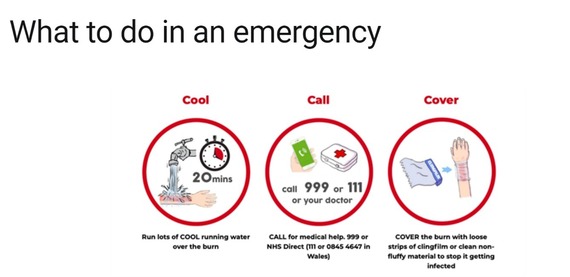We have been notified of a small number of incidents involving children being scalded by hot soup. Although small in number, it is important to prevent any child suffering a scalding incident. Accidents of this kind can happen quickly, and the effects can be devastating. The Child Accident Prevention Trust UK states that overall almost half of all serious burns are to children under two and 70% are to children under five.
You can prevent these types of accidents by taking some easy to implement actions. This information is to raise awareness and should be used in conjunction with the service’s risk management processes and procedures to support staff development. It is not designed as an alternative to appropriate training.
Meal and snack times should be well managed and young children and babies should always be supervised when eating.

(The image above is from the Child Accident Prevention Trust.)
It is important that staff breaks are managed to make sure children have suitable support while eating. Any risks should be identified and minimised and staff should be suitably trained to promote positive, safe, mealtime experiences. Managers must make sure that staff are putting any learning and training into practice to promote safe, happy, and healthy mealtimes.
It is important when you serve hot food that you follow the guidance from the food standards agency to ensure food is heated to the correct temperature before serving. This is to avoid food poisoning. However, food should not be served to children at this temperature. Food should be left to cool in a safe area, away from children and should be tested by tasting, before serving. Remember that young children’s mouths are more sensitive than an adult and they cannot tolerate the same temperature. Where meals are prepared by catering staff, childcare staff should confirm the temperature is safe for the children before serving. Whilst we want to promote children’s independence at mealtimes, when serving hot liquids such as soup to young children, this should be brought to the children rather than children carrying this.
More guidance about management of mealtimes can be found in our Mealtimes Keeping children safe: supporting positive mealtime experiences in early learning and childcare (ELC) practice note.
In the event that an accident does happen in your service, it is vital that you respond, quickly and safely to prevent further damage.
Burns and scalds are damage to the skin usually caused by heat. Both are treated in the same way. Remove anything from near the burnt area, providing doing so does not damage the skin. Cool the burn, with cold running water for a minimum of 20 minutes, as soon as possible after the injury. Never use ice, very cold or iced water.
If running water is not available a wet towel or compress can be used. Initial cooling is important. Although cold water will cool the area down more quickly, a child may be unable to tolerate this. Tepid or cool water may be used if this can be tolerated for longer. The area should then be covered with a clean dressing, cloth or clingfilm. Any burn or scald larger than a 50 pence piece will require medical care. Young children are particularly at risk, and children under 10 should be seen by a medical professional. After initial first aid has been provided, contact NHS on 111 to seek advice or in an emergency dial 999. Parents should also be contacted and advised of the situation; however, you should not delay accessing medical treatment to wait for the parents arrival.
Further guidance
British Red Cross Burns first aid | British Red Cross
NHS 24 Burns and scalds | NHS inform
The child accident trust has a range of fact sheets to help keep children safe.
The Royal Society for the Prevention of Accidents also have a range of resources, including a virtual kitchen to help you consider risks.


